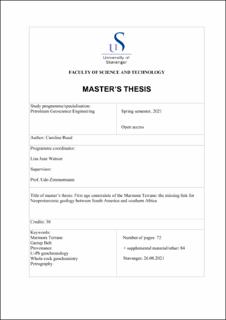| dc.description.abstract | The Gariep Belt stretches from the southwest of Namibia into the northwest of South America, crossing the international boarder at the Orange River. The mountain belt originates from a continent-continent collision related to the break-up of Rodinia and following amalgamation of Gondwana. Although known that the Gariep Belt with its low-grade metamorphosed Neoproterozoic record of rock succession holds information that can allow the understanding of one of the most significant Era’s with regards to understanding palaeotectonic evolution of previous supercontinents and extreme climate conditions with possibly global glaciations, few to non-existing datasets of provenance data exists.
U-Pb analysis of zircons within the Marmora Terrane yield information of new depositional ages and concludes that two subterranes Schakalsberge and Chameis are younger than previously assumed, with age ranges of 550 Ma and 570 Ma respectively. Some rock successions of the latter (Dernburg Formation) have been intruded by gabbroic rocks containing zircons at around 540 Ma. The assumed ages by previous work for the third and last Oranjemund Subterrane are supported by more data and have a maximum depositional age of Uppermost Cryogenian age (c. 630 Ma).
The presence of zircons in all mafic rocks sampled from for this work indicates that the successions are underlain by continental basement and do not represent an oceanic terrane. Hence, palaeotectonic models arguing with the Marmora Terrane being solely oceanic crust are outdated and must be abandoned. The data also argues that the correlation of the succession within the Chameis Subterrane of those within the Schakalsberge Subterrane cannot be anymore based on isotopic data.
Detrital zircon populations match the eastern South America Punta del Este Terrane and the western Kalahari craton, but contains age populations absent within the Rio de la Plata craton (Nico Perez Terrane), indicating that the Marmora Terrane is related to the former units. More speculation about palaeotectonic and -geographic processes would be adventurous.
The resulting dataset of this thesis also demonstrate that depending on U-Pb ages alone solving a paleogeographic puzzle is a far stretch due to overlapping events on both sides of the south Atlantic Ocean. Although obvious that the geological history of the Marmora Terrane is strongly related to the one of eastern South America around the Rio de la Plata area and southwestern Africa with the Kalahari Craton, further research such as isotopic provenance data and quantification of detrital material are paramount to improve our understanding of the source areas during deposition. | |
